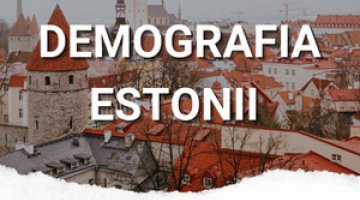How to postpone a demographic crisis. Estonia and the lifeline of immigration

Estonia is the only one of the three Baltic states to have recorded stable population growth in recent years. The main reason for this has been the increasingly positive rates of immigration and re-remigration, which have enabled Estonia to compensate for its negative birth rate. Despite Tallinn’s cautious migration policy, the continuation of these trends will postpone a future demographic crisis, and also enable the state and society to better prepare for population-related challenges in the future.
The trend recorded in Estonia is an exception compared with the situation in the other two Baltic states, which have long grappled with rapid depopulation. The most important factors behind these countries’ population decline include an aging population, high mortality rates, waves of economic emigration, low birth rates and the prevalence of alternative family models (compared with more traditional, nuclear-style families). All this is reflected in structural socio-economic problems affecting not only all three Baltic states (such as emigration) but also the West as a whole (for example rising average population ages). Although Estonia faces similar problems to those affecting Latvia and Lithuania, its population has nevertheless been rising continuously. Statistics compiled for 2011–21 indicate that in that period the Estonian population increased by 2.9%,[1] due predominantly to an increase in immigration and re-emigration to Estonia.
After the country regained independence in 1991, Estonia’s population declined steadily. In the late 1980s and the early 1990s, the country was inhabited by 1.57 million individuals, the largest number recorded in its history. In the closing decade of the 20th century, however, Estonia saw a wave of emigration due to its political and economic situation. This was to a large degree linked with the Russian-speaking residents who had settled in Estonia in the Soviet era and now chose to return to the Russian Federation (RF), and with large-scale economic migration, mainly to Finland. When Estonia joined the EU in 2004, it was inhabited by around 1.36 million individuals. The opening of the borders and the economic crisis of 2007–9 triggered another wave of economic migration. Aside from Finland, other destinations which attracted increasing numbers of Estonian emigrants included Ireland and the United Kingdom.[2] At present, around 16% of all Estonians reside abroad permanently. The countries with the biggest Estonian diasporas include Finland (around 50,000 individuals), Sweden, Canada, the US (around 25,000–27,000) and the United Kingdom (15,000–20,000).
This negative trend continued until 2016 when, for the first time, the figures compiled by the statistical office showed an increase in the number of Estonia’s residents compared with the previous year, a trend which has continued. At present, Estonia’s population consists of 1.366 million individuals, 926,000 of whom are ethnic Estonians and the remaining 440,000 are representatives of ethnic minorities and economic immigrants. The vast majority of the latter are Russian-speaking residents hailing from the countries of the former USSR, who are mainly descendants of Soviet-era settlers. They are usually perceived as Russians. The second largest group of non-ethnic Estonians are Ukrainians who have emigrated to Estonia in recent years seeking employment. Over the last year, there has been a rapid increase in the number of Ukrainians residing in Estonia, linked with the influx of refugees (mainly via Russian territory) from Ukraine’s Russian-occupied regions.
Chart 1. The number of residents and ethnic Estonians in Estonia in 1987–2023

Source: Statistikaamet.
Shifts in migration destinations
Another major rise in Estonia’s population was recorded in 2022; according to the local statistical office, almost 49,400 individuals arrived in Estonia in that year. Considering the number of individuals who emigrated from Estonia and the country’s mortality rate, the population rose by 34,000, 2.6% up on the previous year. Ukrainian citizens accounted for as much as 66% of all arrivals in Estonia in 2022 (33,217), which indicates a 10-fold increase compared with previous years.[3]
Despite visa restrictions imposed on Russians, the number of immigrants from Russia also increased, from 1860 in 2021 to 1918 in 2022. Last year, Estonia recorded an unprecedentedly high number of immigrants. However, this does not spell any increase in selected immigration trends; rather it reflects a temporary deviation in the trend caused by the wave of refugees from Ukraine, who mainly arrived in Estonia via Russia.
The steady increase in Estonia’s population has lasted for seven to eight years, and results from shifts in migration trends. Statistics show that the net migration rate stabilised in 2015, and the number of immigrants rose in subsequent years.
Chart 2. Estonia’s external migration in 2011–2021

Source: Statistikaamet.
In 2015–17, immigration did not have a major impact on Estonia’s general demographic situation; it was only when the number of arrivals increased post-2017 that a rise in the overall number of Estonia’s residents was recorded, as it offset the negative birth rate. According to figures compiled by the Estonian statistical office, the net migration rate recorded from three main regions is of key importance. These are the EU (mainly re-emigration), the countries of the former USSR, and third countries. The increase in the number of re-emigrants (Estonian citizens) and EU residents was the most important factor, as these two groups helped to stabilise the situation post-2015. Another important group was made up of economic migrants from non-EU countries. Immigrants from these countries alone would not have filled the gap left by Estonian citizens who had emigrated. In this group, immigrants from Russia and Ukraine are of key importance. A large portion of the citizens of the RF arriving in Estonia had permanently resided there in the past, and the rest were mainly new economic migrants. IT specialists are an important group of immigrants from the former USSR;[4] they are attracted to Estonia by its dynamically developing technology companies, its tax-payer friendly fiscal system, the widespread use of foreign languages and relatively high salaries.
Table. Selected net migration rates to Estonia according to citizenship

Source: Statistikaamet.
The migration policy in practice
At first glance, Tallinn’s policy does not appear to favour immigration. It is regulated by the Aliens Act of 2010 (with subsequent amendments). Each year, the Ministry of the Interior defines the number of individuals from outside the EU (as well as from outside the US, the UK, Australia and Japan) who can enter Estonia; this figure is set at 0.1% of Estonia’s population in the previous year. The ministry then divides this number into smaller groups corresponding to specific skills or professions. Individuals who fall within these limits are granted a temporary residence permit which enables them to take up a job or start business activity in Estonia. To a certain degree, this concept resembles the model applied in Canada, although it is less flexible and favours highly-skilled immigrants.
Estonian legislation envisages 18 exceptions to facilitate immigration, including with regard to specific professions and positions. The statutory limits do not apply to both individuals and entrepreneurs active in the information and communication technology (ICT) sector. Scientists, students, investors and middle & senior managers whose salary is at least 50% higher than Estonia’s average salary are also subject to special procedures. Family reunification forms the basis of another category of exception.
2022 saw further restrictions being added to those already introduced in order to reduce the number of potential immigrants willing to settle in Estonia; these involved Russian and Belarusian citizens. At the same time, several laws regulating immigration and the process of granting protection to refugees were amended to facilitate the settlement procedures for Ukrainians fleeing war. The most important element of these modifications involved the fact that refugees are granted the right to work according to the same procedure as the one which applies to residents. This means that refugees who do not view Estonia as a transit country are granted a status similar to that of economic migrants (with additional protections).
The restrictions introduced on the basis of the Aliens Act and the visa policy applied to Russian citizens only regulate the actual flow of immigrants to a certain degree. Statistics indicate that their real number exceeds the adopted limits. Many individuals who arrive in Estonia fall within the 18 exceptions mentioned earlier in the text, hold a previously issued residence permit or visa, or already have close family there. According to the Estonian statistical office, Ukrainian citizens are the biggest groups of non-EU residents arriving in Estonia, with Russian citizens the second biggest. As of 2014, a total of around 2000 individuals from third countries entered Estonia annually (net migration); however, post-2017 this number doubled, and in 2021 it stood at almost 6000 individuals.
Chart 3. Net migration of non-EU citizens to Estonia

Source: Statistikaamet.
The number of (ethnic) Estonians has been on the wane
Estonia’s nation-wide demographic statistics for 2022 also include another record figure. In that year the number of births hit a historic low, at 11,646. This means that around 12% fewer babies were born in 2022 than in 2021, and 2500 fewer than the annual average since 1991 (14,000). The mortality rate has also risen significantly over the last two years and is now comparable to that recorded at the turn of the 21st century, when the country’s living standards were considerably lower. The main reason behind this drop involved the ‘excess deaths’ caused by the COVID-19 pandemic.
Chart 4. Estonia’s population growth since regaining independence

Source: Statistikaamet.
The negative birth rate Estonia has experienced almost throughout its independence has not directly affected the number of ethnic Estonians residing in the country in recent years (when analysed in the short term). This is because it has to some degree been offset by re-emigration (see Chart 2) and by an increase in life expectancy.
The negative trend stabilised in 2016 and then reversed. Over the last six to seven years, the number of ethnic Estonians has increased. After hitting a historic low in 2017 (902,000), it gradually rose and reached the figure recorded in 2010–11 (919,000). Despite these positive developments, it is still smaller (by around 47,000) than in the early 1990s.
A (planned) Russification of Estonians?
Increased re-emigration and immigration to Estonia and the rise in the number of refugees residing there have not triggered a significant change in Estonia’s ethnic composition, and the trends currently recorded do not indicate that any such change might occur in the coming years. At the same time, this issue has become an element of public debate and has triggered social polarisation. Politicians from the conservative-nationalist EKRE party (Estonia’s second most popular party) are taking advantage of this situation to disseminate the opinion that increased immigration could result in the country’s eventual Russification.[5] Although this party has promoted similar arguments for several years, last year the narrative intensified due to the large numbers of Ukrainians arriving in Estonia. EKRE was the only political force to oppose the introduction of simplified procedures for war refugees, and its representatives regularly attempt to exaggerate the dangers linked with the increasing numbers of Ukrainian refugees. They are also working to revive the trauma of (older) Estonians which has its roots in the colonisation policy pursued by Moscow during the Soviet era. Despite being false, the EKRE’s narrative suggesting that ‘Russification through immigration’ is imminent meets with a favourable response from a portion of Estonian society because it draws upon mounting fears regarding immigration while reinforcing them at the same time. In this context, it should be noted that it is totally unfounded, and cannot be confirmed using statistics or demographic projections.
Selected statistics compiled over the last decade indicate that, despite increased migration and the change in the country’s population numbers, the proportion of ethnic Estonians to non-Estonians remains stable. For many years the share of ethnic Estonians in Estonian society has remained at 68–69%. At the same time, contrary to politically-driven theories forecasting Estonia’s Russification, since 2020 the number of individuals who identify themselves as ethnic Russians has decreased in favour of ‘other minorities’. Until 2020, 25% of the population considered themselves Russian and 5% identified themselves as ‘others’ (while around 1% said that their ethnicity was ‘unknown’). In 2021, the proportion of Russians was 24% and that of ‘others’ 6% (it rose to 7% in 2022). According to estimates for 2023, the proportion of ethnic Estonians will remain stable (68%), while the proportion of Russians will drop to 22% and that of ‘others’ will increase to 9%.
Chart 5. Estonia’s ethnic composition in 2012–2023 based on selected statistics

Source: Statistikaamet (statistics RV0222 and RV071).
Over the last decade, the number of Estonian Russians has fallen by 30,000. Aside from general, nationwide processes (such as emigration and a drop in the birth rate), this was due to objective differences between Estonians and national minorities as regards mortality rate and life expectancy. The latter is on average 1.5–2 years less for representatives of national minorities than for Estonians. As regards healthy life expectancy, the difference is 2–3 years. This is determined by one’s place of residence rather than ethnicity, as indicated by statistics from Estonia’s north-eastern region, which is mostly inhabited by representatives of other nationalities; the situation in the south-eastern region of Võrumaa is similar. The ethnic Estonian portion of the population is also statistically younger than the minority groups.
Another likely factor for the decline in the number of Estonian Russians are differences in their desire to return from emigration. This conclusion is prompted by the fact that the number of ethnic Estonians has increased in recent years, while the number of individuals who identify themselves as Russians has gradually declined.
The proportion between these groups is also affected by identity shifts recorded in the younger generation. One study carried out in 2019 showed that in this group the Russian identity of their parents and grandparents has blurred, and often takes on a hybrid form which contains various elements of Estonian and Russian identity.[6] A mere 33% of the Russian-speaking Estonian young adults surveyed (18–35-year-olds) referred to themselves as Russians. The rest identified themselves as Russian Estonians (24%), Estonian Russians (5%), Russian-speaking Estonians (13%), Russian Europeans (8%) and other groups. Surveys indicate that for the younger generation historical memory shared with Russians residing in the Russian Federation and membership of the Orthodox Church are not particularly important. The former was considered important by 51% of the respondents, and the latter by 32%. On the other hand, the Russian language continues to be an important element of identity (as indicated by 79% of the respondents).
The relatively lower birth rate and the processes involving the integration and Estonisation of the younger generations will result in greater social cohesion in the future. The proportion of individuals who consider themselves Russian will decrease. Despite increased migration, these processes taken together will reduce rather than intensify the ‘Russification’ of the country.
Outlook
The demographic shifts will likely have a positive effect, and will enable Estonia to avoid some of the problems faced by Latvia and Lithuania. The pace of Estonia’s depopulation will likely be relatively slower than that recorded in these two countries.
Demographic projections by the Estonian statistical office include several scenarios of how the situation will develop by 2050. According to the most likely scenario, by that year Estonia’s population count will stand at 1.27 million, a decrease of 87,000 individuals over the previous three decades. By 2080, the projections spell a population decline down to 1.18 million individuals, that is by 180,000 individuals. This decrease is smaller than the one recorded in the period between the demographic boom of the late 1980s & early 1990s and the most critical year 2017 (230,000 individuals).
More optimistic scenarios are also considered, in which the number of Estonians remains unchanged compared to today’s population count. These concepts assume an increase in fertility rate and a scale of immigration which is maintained or even increased. Maintaining a population size similar to the present one would require a fertility rate that ensures generational replacement. However this is unlikely, as is an increase in the number of immigrants. This is due to the current lifestyle of the younger generation (low fertility rate) as well as identity and political issues (society’s unfriendly attitude towards immigration).[7] The worst-case scenario spells a further decline in fertility rate and a collapse in migration trends. Should this scenario materialise, by 2050 Estonia’s population will stand at 1.13 million, and at just 900,000 in 2080.
It seems that despite Estonians’ unfriendly attitude towards immigrants, immigration is the optimal (albeit not the perfect) way to solve the country’s demographic problems. However, to maintain the present trend Estonia needs to tackle several challenges. One of the biggest is how to preserve the potential of the national economic model while maintaining or even boosting the attractiveness of the labour market, in order not only to attract immigrants but also to maintain and boost the trend to re-immigration. In this context, Estonia’s economic problems and the decline in the quality of life, linked with the consequences of the war in Ukraine and the COVID-19 pandemic, may hamper these initiatives. According to estimates prepared by the Ministry of Finance and the Bank of Estonia, in 2023 the Estonian economy will shrink by 1.5% and the budget deficit will stand at €1.7 billion, or 4.3% of the country’s GDP.
A greater influx of immigrants will also exacerbate regional inequalities. Immigrants usually settle in more affluent metropolitan areas such as Tallinn and Tartu. Taking internal migration trends into account, in the long term this will result in provincial regions becoming depopulated and impoverished, and the two biggest cities expanding further. Another challenge involves efforts to adjust the integration policies to citizens’ needs and to the future labour market. An ageing Estonian population will also force the government to reform the social welfare system.
It seems that immigration and re-emigration are Estonia’s allies, as they will give it the time it needs to implement the necessary reforms. The increasing automation of services, which boosts Estonia’s potential for coping with an ageing population, is another silent ally. However, a transition to enable Estonia to take in more immigrants and accelerate the pace of innovation in the service sector will require Estonians to quickly modify their mindset, which may not be an easy task.
[1] О. Звягинцева, ‘Департамент статистики: за десять лет население Эстонии выросло почти на 3%’, Err.ee, 14 April 2023, rus.err.ee.
[2] K. Anniste, T. Tammaru, E. Pungas, T. Paas, Emigration after EU enlargement: was there a brain drain effect in the case of Estonia?, The University of Tartu FEBA, Tartu 2012, academia.edu.
[3] Figures compiled by Estonian state administration offices indicate that most Ukrainian refugees are doing relatively well on the Estonian job market; 44% of individuals from the 20–64 age group have found employment there.
[4] М. Бегункова, ‘Войти в айти: почему иностранные айтишники выбирают Эстонию для работы и жизни’, Postimees, 15 June 2021, rus.postimees.ee.
[5] EKRE politicians support a local variant of the Great Replacement, a racist theory conceived in France by Renaud Camus. It argues that the elite is involved in a great demographic and cultural replacement of populations, involving replacing white ethnic Frenchmen and -women with a Muslim non-white population. Similar conspiracy theories emerged throughout the 20th century in Germany, Italy and Austria. They are based on a belief in an alleged conspiracy intended to trigger demographic shifts targeting the indigenous European population.
[6] D. Teperik, G. Senkiv, Primary world-view characteristics of Russian-speaking young adults in Estonia, National Centre of Defence and Security Awareness, Tallinn 2019, quoted after: researchgate.net.
[7] The most recent surveys (conducted in 2016 and 2017) indicate that in their attitude towards immigration Estonians are among the most hostile nations in the EU. Fear of the immigrants is more prominent in the older generations of Estonians, who still remember the Soviet era. For more see ‘Estonia among countries least accepting of migrants, survey shows’, Err.ee, 25 August 2017, news.err.ee.





